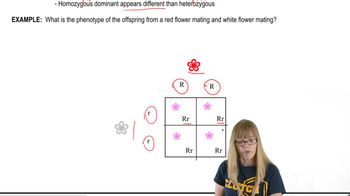- 1. Introduction to Genetics51m
- 2. Mendel's Laws of Inheritance3h 37m
- 3. Extensions to Mendelian Inheritance2h 41m
- 4. Genetic Mapping and Linkage2h 28m
- 5. Genetics of Bacteria and Viruses1h 21m
- 6. Chromosomal Variation1h 48m
- 7. DNA and Chromosome Structure56m
- 8. DNA Replication1h 10m
- 9. Mitosis and Meiosis1h 34m
- 10. Transcription1h 0m
- 11. Translation58m
- 12. Gene Regulation in Prokaryotes1h 19m
- 13. Gene Regulation in Eukaryotes44m
- 14. Genetic Control of Development44m
- 15. Genomes and Genomics1h 50m
- 16. Transposable Elements47m
- 17. Mutation, Repair, and Recombination1h 6m
- 18. Molecular Genetic Tools19m
- 19. Cancer Genetics29m
- 20. Quantitative Genetics1h 26m
- 21. Population Genetics50m
- 22. Evolutionary Genetics29m
You have four guinea pigs for a genetic study. One male and one female are from a strain that is pure-breeding for short brown fur. A second male and female are from a strain that is pure-breeding for long white fur. You are asked to perform two different experiments to test the proposal that short fur is dominant to long fur and that brown is dominant to white. You may use any of the four original pure-breeding guinea pigs or any of their offspring in experimental matings. Design two different experiments (crossing different animals and using different combinations of phenotypes) to test the dominance relationships of alleles for fur length and color, and make predictions for each cross based on the proposed relationships. Anticipate that the litter size will be 12 for each mating and that female guinea pigs can produce three litters in their lifetime.
 Verified Solution
Verified Solution
